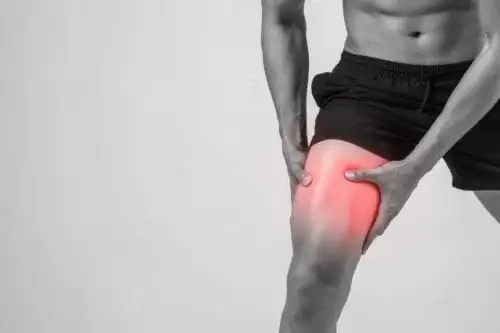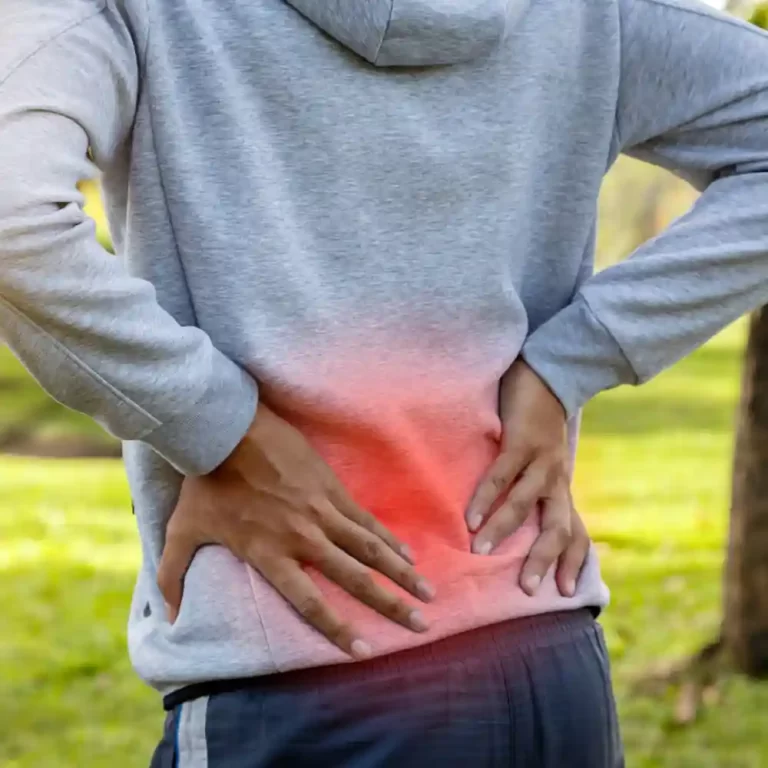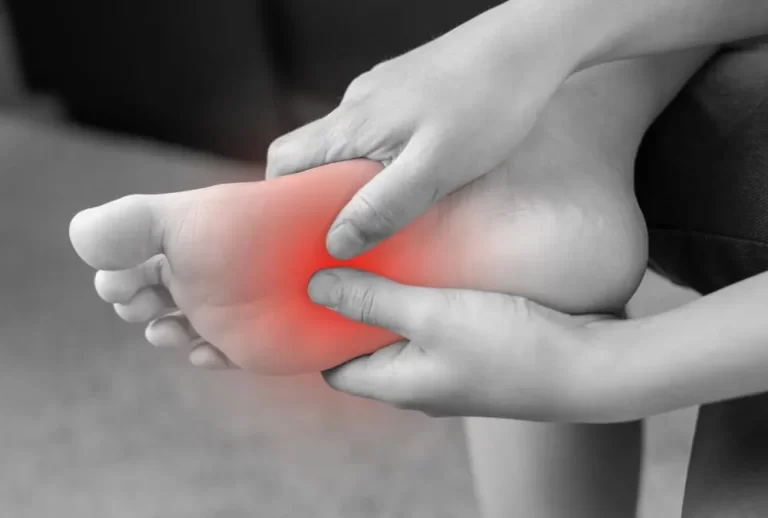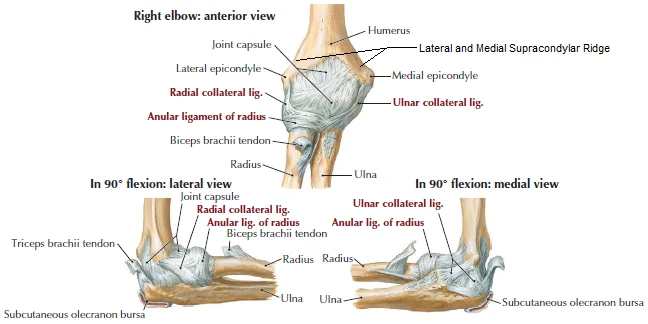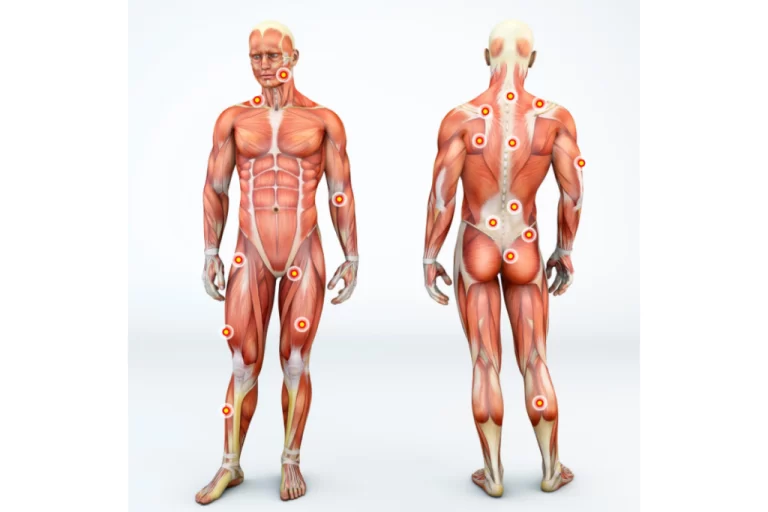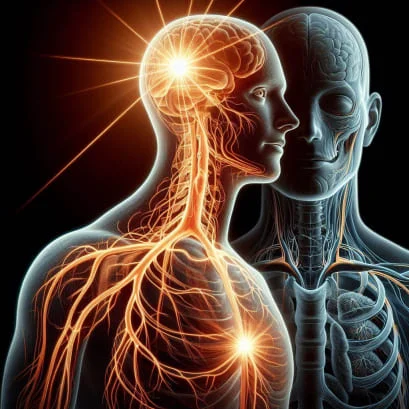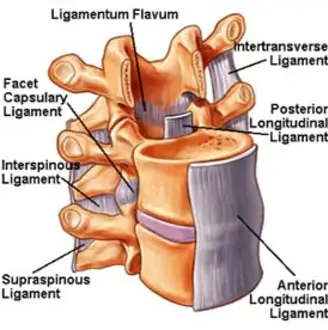Thigh Muscle Pain
What is a Thigh Muscle Pain?
Thigh muscle pain, also known as muscle pulls or tears, typically occurs when a thigh muscle is overextended, causing the muscular tissue to rip during an action like running or kicking a ball. They frequently appear close to where the muscle attaches to the tendon’s thick, fibrous connective tissue. A direct hit to the muscle results in the same harm. Thigh muscle pain can be extremely painful.
Three sets of powerful muscles make up the thigh: the quadriceps muscles in the front, the hamstring muscles in the rear, and the abductor muscles on the inside. Bending the leg and extending the knee are controlled by the quadriceps, which are found at the anterior accept of the thigh. The Rectus Femoris, Vastus Medialis, Vastus Lateralis, and Vastus Intermedius are the four muscles that make up the quadriceps group. The legs are held together by the adductor muscles.
Because they traverse both the hip and knee joints, the hamstring and quadriceps muscle groups are especially vulnerable to pain. They are also utilized for high-speed sports including football, basketball, soccer, and track and field competitions (running, hurdles, and long jump).
Where is the thigh muscle located?
Many of the largest muscles in the body are found in the thighs. Thanks to the thigh muscles, the lower body can flex, bend, and rotate. Additionally, they aid in balance by bearing most of the body’s weight and maintaining the alignment of the hips and legs.
Thigh muscles are frequently categorized according to their position and function:
- Adductors muscles
- Hamstrings muscles.
- Pectineus.
- Quadriceps.
- Sartorius.
The obturator externus, gracilis, adductor longus, adductor brevis, and adductor magnus are the five muscles that make up the adductors. They are located inside the thigh, extending from the pelvis to the femur (thigh bone).
The semitendinosus, semimembranosus, and biceps femoral are the three muscles that make up the hamstrings. They begin at the hip, just below the knee, and travel down the back of the leg.
From the front of the pelvis to the top of the femur, the pectineus may even be a flat muscle.
The vastus lateralis, vastus medialis, vastus intermedius, and rectus femoris are the four main muscles that make up the quadriceps and are situated in the anterior region of the thigh. They start at the femur (thigh bone) and pelvis (hip bone), and they go down to the patella (kneecap) and tibia (shin bone).
The longest muscle in the human body is Sartorius’s, which is long and thin. It begins from the hip, crosses the front of the thigh, and then descends to the knee.
What are the causes of thigh pain?
Muscular pain is often the cause of thigh pain.
Some of the most common pain in the thigh region include the following:
Sprains and strains in the muscle
- When a ligament is stretched or in pain, a sprain results. Tendons connect the muscles to the bones, while ligaments are the connective structures that keep bones together.
- The following are the most typical signs of sprains and strains:
- falling unexpectedly as a result of overstretched joints or after a vigorous workout.
- The anguish radiates.
- The area surrounding the pain was the source of the edema.
pain due to excessive usage
- Overuse pain can occur when a person does not warm up before exercising or when a muscle in or around the thigh is strained for an extended length of time. Pain following strenuous physical activity or exercise is the most typical sign of overuse pain. This type of pain has the potential to harm both thighs.
Pain in the nerve
- Pain can also be caused by nerves in the upper thigh. Damage to the nerves results in nerve pain.
A sedentary lifestyle
- Sitting too much or not moving around much each day might also cause muscle soreness. The joints and muscles may be strained as a result, particularly the hips and legs. Inactivity can cause muscles to weaken, which can lead to generalized muscle pain.
Due to other pain body parts
- pain in other areas of the body may also be the source of pain in the upper thighs. For instance, hip pain may also result in thigh pain.
- Deep vein thrombosis (DVT), the most worrisome cause of thigh pain, has the potential to be lethal if left untreated. You should see a physician immediately if you experience any of the following symptoms:
- Lack of breath
- Chest pain that could radiate to your arm, jaw, neck, and shoulder
- An irregular heartbeat
- dizziness
- The tongue was covered in blood
Sing and Symptoms of thigh muscle pain
Typical signs of muscle pain include the following:
- A popping or snapping sound as a result of strained muscles.
- abrupt and excruciating pain.
- If there is obvious bruising and broken blood vessels, the damaged area may also be painful to the touch.
Grade 1
The symptoms of grade one thigh pain may not appear until the exercise is over. Additionally, there might be a minor soreness when the muscles are stretched or tightened, as well as a cramping or tight feeling in the thighs.
Grade 2
A grade two thigh strain causes pain when walking and causes instant pain that is worse than that of a grade one pain. Pain during muscle contraction and stretch serves as confirmation. Usually, a grade two thigh pain hurts to the touch.
Grade 3
A grade three thigh pain is a dangerous pain that can result in a total muscle rupture. The athlete can’t walk pain-free because of the sudden scorching or stabbing pain. The site of the tear is frequently accompanied by a bump above the thigh’s hollow. Grade two and three pain will result in a huge bruise below the site of the pain within a few days due to internal bleeding.
Complications of thigh muscle pain:
The following complications may arise:
- Reduced mobility
- Diminished strength of muscles
- If surgery is necessary to correct a strain, pain, and infection may result.
Diagnosis of thigh muscle pain:
- During a physical examination, your doctor can identify thigh muscle pain.
- Examine medical history to determine the onset of symptoms and possible activities that may have contributed to the sprain or strain.
- Additionally, the doctor will check for swelling in the thigh region, which might be a sign of a strain or tear in the quadriceps or hamstrings. Your doctor may also request an MRI or X-ray to confirm your diagnosis.
- An X-ray will provide you with a two-dimensional picture of your thigh, hip, knee, and pelvis as a whole. They aid in the detection of aberrant bone forms, avulsion fractures, instability, and other issues.
- Muscles and tendons can be examined internally using diagnostic ultrasounds and CT scans.
- More details and an assessment of the soft tissues surrounding your hip joint can be obtained via an MRI. In addition to helping to assess the degree of your pain, the grade of your tear or inflammation, and other related issues, they can detect damage to your tendons or ligaments.
Treatment of thigh muscle pain:
Medical Treatment
Surgery is rarely required for thigh muscle strains, although it can be required for a full rupture.
For immediate
- Conservative, nonsurgical care Most muscle pain don’t require surgery, but if the muscle is completely painful, experts advise it. The athlete can also repair a partial gash after they are comfortable and have normal strength and movement. This usually happens after many weeks to several months of intensive therapy and treatment. The athlete may benefit from surgical restoration if the muscle is completely destroyed. Take care of a strained muscle.
- Similar to over-the-counter (OTC) medications like naproxen sodium (Aleve), aspirin, and ibuprofen (Advil, Motrin IB), some therapists advise against using anti-pain medications that increase your risk of bleeding during the first 48 hours following a muscle pain.
- During this time, acetaminophen (Tylenol) and other medications may be useful for pain management.
- You can improve the stability and strength of the pain joint or limb with the assistance of a physical therapist. A brace may be recommended by your physician to stabilize you. Thigh muscle sprint surgery may be necessary for certain muscle pain.
To use the RICE principle as first aid to prevent pain and swelling:
- R- rest
- I- ice for cooling
- C- compression tapping and splinting
- E- elevation
R.I.C.E approach
- The RICE regimen is frequently used to treat the majority of muscular pain.
- As a result, the tissues’ edema and hemorrhage were reduced. More active rehabilitation can begin once the initial days of rest have passed.
The joint’s pressure will be released and the pain will be somewhat reduced with rest. keep away form actions that make the situation worse. - Pain and inflammation can be reduced by applying ice to the affected area. Try using ice for ten to fifteen minutes, two or three times a day.
Applying a gentle bandage or ace wrap to the wounded region will help to avoid further swelling.
Swelling is lessened by elevation. Your leg should be raised above your heart.
Physical Therapy Treatment:
- The purpose of exercise therapy is
- Reduce pain in the thigh muscles
- Diminish the edema of the muscles
- strengthens the muscles in the thighs.
- Increase the ligament’s and the related joint’s complete range of motion
- regain the patient’s trust
- Restore all of the patient’s functional abilities.
Acute stage
After 48 hours after the pain, physical therapy rehabilitation can begin. To reduce pain and swelling during the first few days, use an electric modality.
Electrotherapy
- Ultrasound Tissue healing has been accomplished with ultrasound.
- improves movement and blood circulation.
- To lessen pain and swelling
- The use of cryotherapy
- Using cold water baths and ice packs as part of cryotherapy can help reduce edema and inflammation in the affected area.
- It is advised to apply colds continuously for 15 to 30 minutes at a time, multiple times throughout the day.
- TENS
- IFT, or inferential treatment
- IFT appears to be used for the following primary clinical applications:
- Pain alleviation
- Stimulation of muscles
- Enhanced blood flow in the area
- decrease in edema
Strengthening exercise
Active range of motion exercises
- When motion is especially restricted in the early phases of therapy, this exercise is helpful.
- Just straighten and flax the knee through its whole range of motion without experiencing any pain.
- This will be carried out while standing, sitting, and lying down.
- Avoid overstretching yourself too soon. If it hurts, stay away from it!
- At least three times a day, complete ten repetitions at a time.
Isometric quadriceps contractions
- Early on in the rehabilitation phase, static contractions are frequently performed. They entail tightening the muscles without causing the leg to move. Standing or sitting with the legs straight out is how this will be done.
- Ten seconds at a time, hold.
- Ten repetitions should be done after five seconds of relaxation. Increase the number of sets to three or five sets of twenty reps as your strength increases.
- Despite being monotonous, this workout will help you maintain muscle mass and return to full fitness more quickly.
- Until you are able to complete the concentric movements below, keep doing this exercise every day.
Adductor Squeeze (Crook Lying)
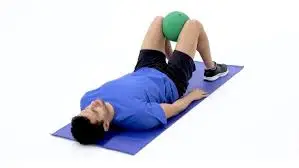
- With a rolled towel or ball in the center of both knees, start this groin-strengthening exercise while lying on your back in a knee-bending position.
- Squeeze the ball slowly in the center of both knees to contract the adductors, the muscles on the inside of the thighs.
- Hold for five seconds.
- Perform ten to fifteen repetitions.
Straight leg raise
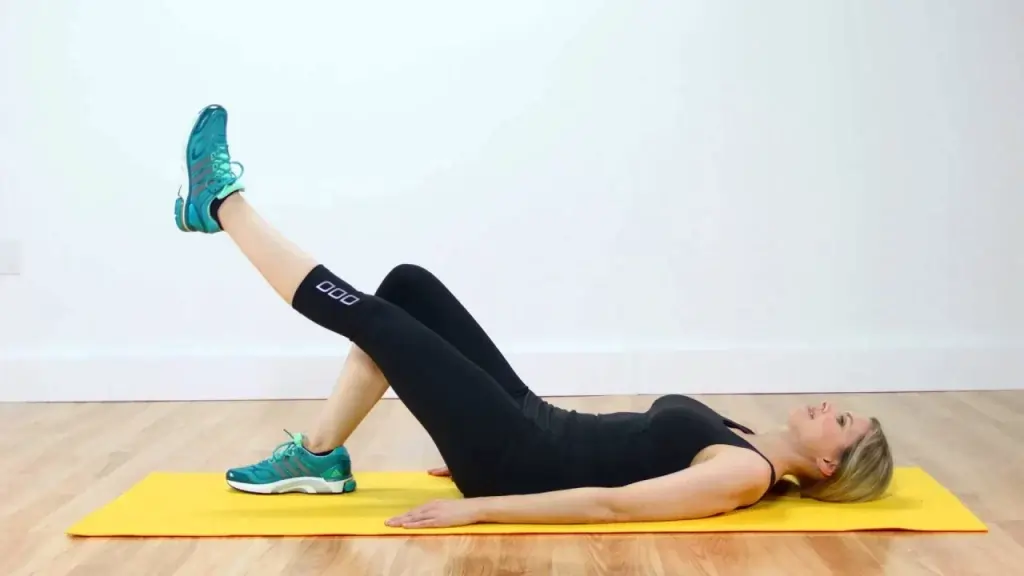
- This is a more difficult workout. With your feet turned outward, sit up straight. Raise one leg just a little bit above the ground and extend it outward without touching the ground.
- If you are strong enough, take the leg out again without resting, or return to the center and rest for two seconds.
- This exercise was advanced to include doing it on a bed with one leg relaxed down the couch side.
- Eight to ten times, raise the leg upward, cross it over the other leg, then lower it.
One leg standing
- Place your weight evenly on both legs and stand with your feet hip-width apart.
- Your hands should be on your hips. Bend your right leg back at the knee after raising it off the floor.
- Hold the pose for up to 15 seconds, or as long as you can keep proper form.
- returning to the initial position.
- On the left side, repeat.
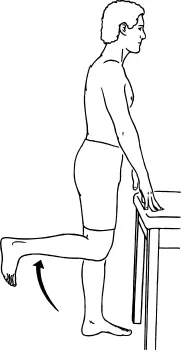
Standing knee flexion
- Using just gravity as resistance, bend the left leg while standing on the right leg.
- As an early-stage exercise, start out slowly and gently.
- Every day, try to complete three sets of ten to fifteen repetitions, working your way up to four sets of fifteen to twenty.
- To further increase the stress, ankle weights are frequently employed.
Resistance Band Hip Adduction
- Place both feet together and stand erect. Secure your ankles with a resistance band.
- Use your hands to support yourself while holding a soft object. Depending on your level of fitness, you will also complete this task without assistance.
- Stretch as much as you can while raising the appropriate leg on your side while maintaining your left leg firmly on the ground.
- To relieve the pain on the resistance band, pause and return your leg to its starting position.
- Stretch the band while keeping your right leg firmly in place, then bring your left leg up to your sides and start over.
- To strengthen the groin muscles and, consequently, the knees, repeat this exercise multiple times. Additionally, it keeps the knees from dropping during squatting and sprinting.
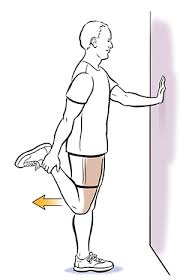
Stretching and strengthening exercise
Static quadriceps stretch
- You can do this while standing or lying on your front.
- Pull the damaged leg’s foot in the direction of your buttocks until the front of your thigh begins to gently stretch.
- Tilt your hips back to prolong the stretch.
- Hold for 15–30 seconds.
- For each set, repeat three times.
Lunges

- Your rear knee should be a few inches off the ground when you lower your torso and bend your knees.
- At the underside of the motion, your weight is evenly distributed between both legs, the back knee points toward the floor, and the front thigh is parallel to the bottom.
- As you continue, maintain your weight on the front foot’s heel to return to the starting position.
Wall squats
- Slowly lower your body from your starting posture and keep it there for a while. Increase the amount of time you hold the wall squat as you get better.
- Pay attention to your head, back, and pelvis against the wall.
- Make sure the movement is painless. Squeezing a ball between your knees while performing the exercise is an alternative that might enhance VMO activation. The ball’s diameter would normally be around 12 inches.
- Once a day, perform three sets of holds lasting 15 to 20 seconds.
Plie Squat
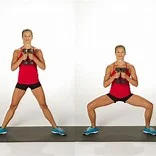
- Place your hands on the front of your thighs, close to your groin, and stand together.
- Your toes should point outward on one side and inward on the other as you spread your feet wide apart.
- Lean on your hips and bend your knees. Raise your hands straight in front of you while maintaining your weight on your heels.
- Hold for a moment, then straighten your legs by pushing your heels to return to your starting position.
- To make this exercise more intense, you will also perform it while holding weights in your hands. Perform one set of eight repetitions.
Step up
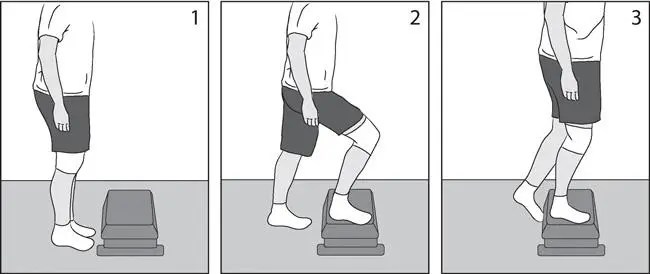
- Press the heel to straighten your left leg as you take a step up with your left foot.
- On top of the step, bring your right foot up to contact your left foot.
- Step back down using your right foot while bending your left knee.
- Lower the left foot till it touches the right foot on the ground.
Lateral hops
- Leap side to side, over a hypothetical barrier, while keeping your legs together. Try to stay on the balls of your feet and land with soft knees.
Squat jump
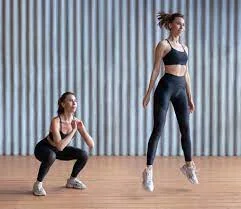
- Start with a standard squat, then jump up with force while using your core.
- To finish one exercise, lower your body back into the thickset posture after landing.
- Make sure your entire butt is on the ground when you back down.
- Perform 10 reps two or three times a day.
Precautions
- The following safety measures will assist you avoid straining your muscles:
- Engage in a daily exercise regimen to condition your muscles. Inquire with your doctor about fitness regimens appropriate for your age and level of activity.
- Before beginning any workout or sporting activity, including practice, warm up. Your body gets ready for more strenuous activities with an honest warm-up. It boosts the temperature of your muscles, speeds up your breathing, and improves blood flow. Warming up can help improve range of motion and decrease stiffness while allowing your body to adjust to the demands of activity.
- After working out, take some time to relax. Hold each stretch for a few seconds to give the muscle time to extend and react. This page offers examples of stretching exercises; you can also ask your coach or doctor for assistance in creating a routine.
- Before returning to sports after a pain give the muscle the time it needs to recuperate. Await the recovery of your muscular strength and flexibility to their pre-injury state. For small pain, this will take 10 days to 3 weeks, and for severe pain, such as hamstring pain, it may take up to 6 months.
FAQs
What illness results in thigh pain?
A disorder called meralgia paresthetica makes the outside of the thigh tingly, numb, and burning. It is caused by compression of the nerve that gives the thigh’s skin its sensation.
How can I use home remedies to treat thigh muscle pain?
Rest, heat, ice, compression, elevation, and light massage are all common at-home treatments for minor pain. Medication for chronic pain that cannot be explained is another option for reducing upper thigh pain. medicine for long-term ailments including arthritis and fibromyalgia.
What is the best tablet for thigh pain?
Drugs: Mild to severe thigh pain can be managed with over-the-counter pain medications like acetaminophen or nonsteroidal anti-inflammatory medicines (NSAIDs). Prescription drugs may be necessary for severe pain.
Which workout is most effective for thigh pain?
Full standing hamstring stretch
Lying on your back, raise one leg to your chest to stretch the back of your thigh.
Your hands should be behind your knees.
Pull your leg gently toward your chest; the back of your aching thigh should feel stretched.
After ten seconds of holding, put your leg back on the bed.
How can a thigh muscle heal the quickest?
Handling and Therapy
The RICE method which stands for rest, ice, compression, and elevation may be recommended by your healthcare professional. You should use an ice pack a few times a day and refrain from activities that exacerbate your pain. To reduce swelling, you can also use an elastic bandage over your thigh.
What is the most effective way to treat thigh pain?
Musculoskeletal pain can be effectively managed with the use of heat or ice. Ice is especially helpful if your thigh issue is caused by pain. If there is no swelling and your symptoms are not connected to a recent accident, you can try using heat to help your pain levels.
Can physical therapy alleviate thigh pain?
For people with upper leg pain, thigh pain physical therapy is essential to regaining comfort and mobility, regardless of the cause of pain, strain, or chronic diseases.
Which techniques work best for thigh muscle relaxation?
Bring your soles together till they contact while bending your knees. Lower your knees to the floor to stretch your groin muscles. Do it three times.
What signs of thigh blood clots are present?
You would have pain, swelling, or tenderness in the affected area if you had a blood clot in your thigh. Additionally, a feeling of redness and warmth may be a sign of a blood clot.
What is a thigh muscle pain?
Although it can happen to anyone, athletes are more likely to experience muscular pain than anyone else. The quadriceps and hamstrings work together to bend (flex) and straighten (extend) the leg. Any pain in the muscles that pull the legs together, known as the adductor muscles, will result in thigh pain.
What signs of thigh muscle are present?
a popping or snapping sound as a result of strained muscles.
abrupt and excruciating pain.
If there is obvious bruising and broken blood vessels, the damaged area may also be painful to the touch.
Should a tight muscle be stretched?
Stretching a strained muscle can only make it worse, even though it will seem counterintuitive. The best course of action is to remain at rest until the pain goes away and to prevent any movement that puts pressure on the affected area. As long as it is done a few days after the pain, light stretching can help with small pain.
What differentiates a muscle tear from a pain?
Occasionally, one, many, or all of the muscle fibers are torn, and the pain is more severe. In this instance, you have a torn muscle. A pain known as muscle pain results from overstretching a muscle or tendon
How does a tightness in the thigh feel?
Thigh pain that feels like a popping or snapping sensation is the primary sign of thigh pain. Additional symptoms and indicators could include: pain when using the affected muscle or when walking. pain, edema, or bruises in the affected thigh.
How should a strained thigh muscle be treated right away?
Rice comes to rest.
Compression,
elevation,
ice.
References
- Patel, P. (2022c, September 29). Thigh muscle strain – Cause, Symptoms, Treatment, Exercise. Samarpan Physiotherapy Clinic. https://samarpanphysioclinic.com/thigh-muscle-strain/
- Hospitals, A., & Askapollo. (2024b, October 15). Thigh pain: causes, treatment & symptoms. Apollo Hospitals Blog. https://www.apollohospitals.com/health-library/thigh-pain-causes-treatment-symptoms/

